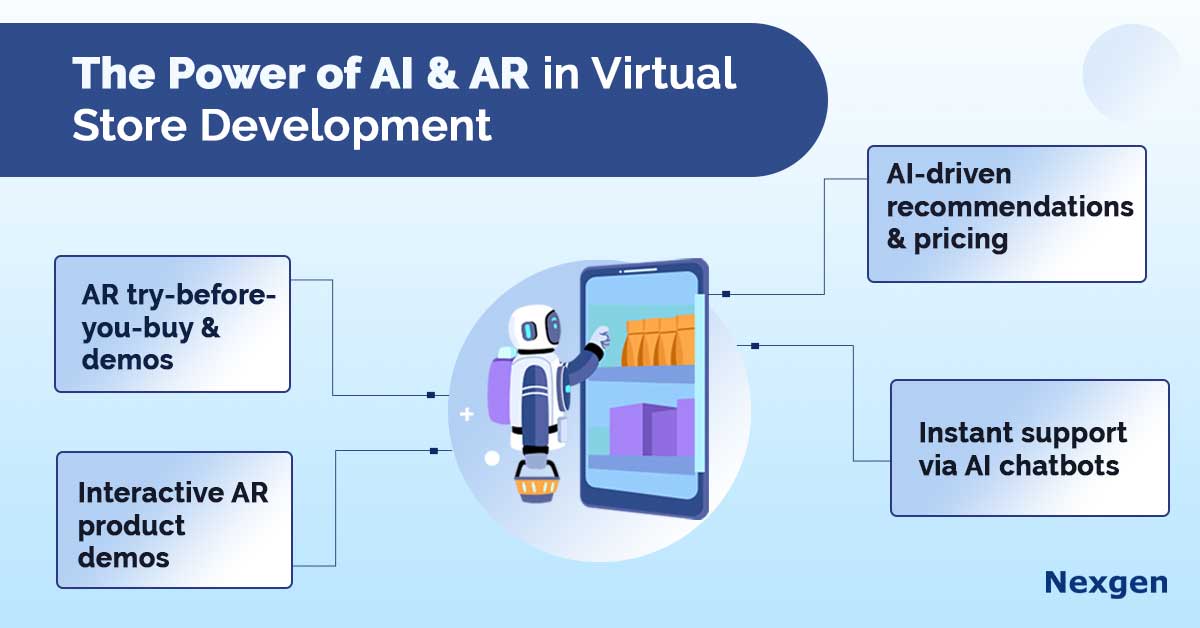As the retail industry continues to evolve, virtual stores are becoming an essential part of the customer's shopping experience. The combination of Artificial Intelligence (AI) and Augmented Reality (AR) is driving innovation, enabling retailers to offer immersive, personalized, and efficient virtual shopping experiences. In this blog, we will explore the transformative role AI and AR play in virtual store development and how they help retailers stay competitive in an ever-changing market.
AI: The Brain of the Virtual Store
AI plays a crucial role in creating personalized and engaging virtual store experiences. Here is how:
- Personalized recommendations:AI algorithms analyze customer data, such as browsing history, purchase history, and preferences, to offer highly personalized product recommendations. This ensures that customers are presented with products they are most likely to be interested in, enhancing their shopping experience.
- Chatbots and virtual assistants: AI-powered chatbots and virtual assistants provide real-time customer support, answer questions, and guide customers through the virtual store. These intelligent agents can understand and respond to natural language, making interactions seamless and efficient.
- Dynamic pricing and promotions: AI can analyze market trends, competitor pricing, and inventory levels to dynamically adjust prices and offer targeted promotions. This ensures that customers get the best possible deals while maximizing revenue for the retailer.
AR: Bringing Products to Life
AR technology adds a new dimension to the virtual store experience by allowing customers to visualize products in their own environment.
- Try-before-you-buy: Customers can use their smartphones or AR glasses to "try on" clothes, accessories, and even furniture in their own homes. This helps them visualize how the product will look and feel in their real-life setting, reducing the risk of returns and increasing customer satisfaction.

- Interactive product demonstrations: AR can be used to create interactive product demonstrations, allowing customers to explore the features and functionality of products in a more engaging and informative way. For example, customers can virtually assemble furniture or test drive a car using AR.
- Gamified shopping experiences: AR can be used to create gamified shopping experiences, such as treasure hunts and interactive challenges, making the shopping process more fun and engaging for customers.
Conclusion
AI and AR are revolutionizing the retail industry by creating personalized, engaging, and immersive virtual store experiences. As these technologies continue to evolve, we can expect to see even more innovative and exciting developments in the world of virtual shopping. These advancements not only enhance customer satisfaction but also empower retailers to optimize store layouts and product placement with unprecedented precision. By merging data-driven insights with immersive shelf planning strategies, the future of retail promises to bridge the gap between online convenience and in-store engagement.
Overview of Nexgen POG
Nexgen POG is a robust and user-friendly cloud-based
planogram software. It is designed for quick and efficient planogramming with minimal effort. Planograms in retail can be designed by easily dragging and dropping the products. The multi-device compatibility feature of POG allows you to obtain, share and edit planogram on any device, including your phone. It helps in designing store-specific planograms for increased product visibility and sales.
Get Your Free Trial Now!